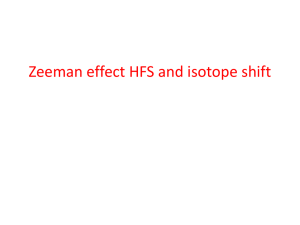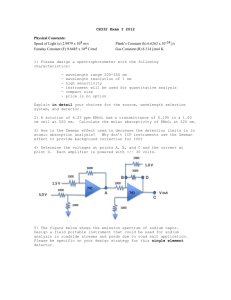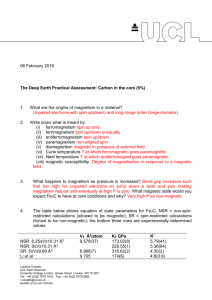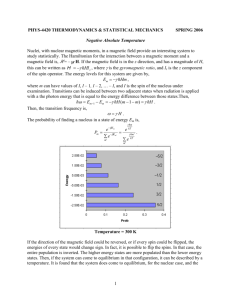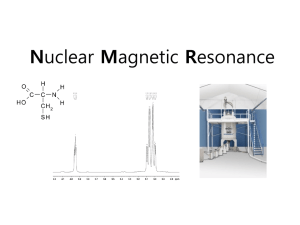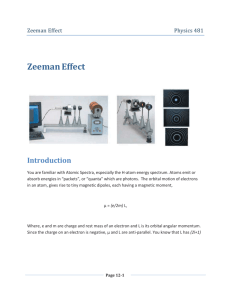Lectures 14-17 EXTERNAL MAGNETIC FIELDS
advertisement
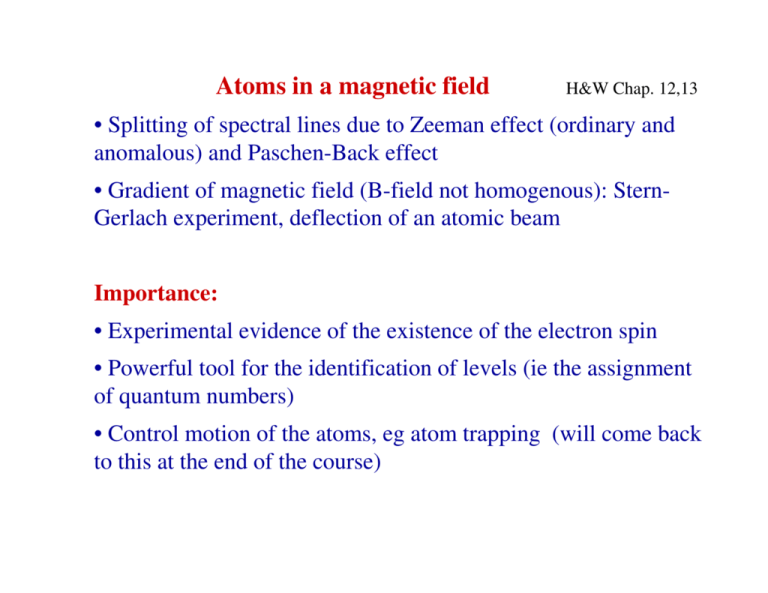
Atoms in a magnetic field H&W Chap. 12,13 • Splitting of spectral lines due to Zeeman effect (ordinary and anomalous) and Paschen-Back effect • Gradient of magnetic field (B-field not homogenous): SternGerlach experiment, deflection of an atomic beam Importance: • Experimental evidence of the existence of the electron spin • Powerful tool for the identification of levels (ie the assignment of quantum numbers) • Control motion of the atoms, eg atom trapping (will come back to this at the end of the course) Ordinary Zeeman effect r B0 // z Magnetic energy is given by r = − µ j ⋅ B0 r Vmag r B0 = homogenous external field r r r µ j = total magnetic moment of the atom = µl + µ s Let’s consider first the case of spin 0 states: r µs = 0 we are left with purely orbital magnetism Ordinary (or “normal“) Zeeman effect For instance Cadmium has two electrons in the outer shell, whose spins are antiparallel total S=0 (more on this later) Total Hamiltonian: H = H atom + Vmag r e = H atom − µl ⋅ B0 = H atom − µl , Z B0 = H atom + lZ B0 2m0 r Our aim is to derive an expression for the shift in energy due to the 2nd term. We note that the eigenfunctions ψ nlm of the atomic Hamiltonian are also eigenfunctions of lZ (with eigenvalue hml ). Therefore we can calculate Vmag on these eigenfunctions and we obtain: Vmag e = hml B0 2m0 Vmag = ml µ B B0 ml = −l ,−l + 1,...,+l (2l + 1 values) This is the final result for the ordinary Zeeman effect (purely orbital magnetism) Splitting into 2l+1 magnetic levels Note that m-degeneracy is now lifted: physically, the B-field introduced a preferred direction and H is not spherically symmetric anymore. Example of ordinary (or “normal“) Zeeman effect: Cadmium ml Distance between adjacent magnetic levels: ∆E = µ B Bo Selection rule: ∆ml = 0, ± 1 ∆ml = 0, π transition ∆ml = ±1, σ transition Shifted Zeeman components: ∆ml SPECTRUM ω µB δω = Bo h In summary, this type of splitting is observed for spin 0 states (pure orbital magnetism). Vmag = ml µ B Bo Before we move on to the anomalous Zeeman effect, let’s analyse the ordinary Zeeman effect by means of the vector model. Vector model = classical description of the behaviour of angular momentum vectors 0 r torque τ = µ l × B0 r dl τ= Newton’s law dt r r l µl = − µ B h r dl µB r r =− l × B0 dt h r l sin θ r l r µl This is the equation of the motion for l. The resulting motion is a precession about the direction of the B-field. The precession frequency is known as Larmor frequency ω L= µB h B0 and it coincides with the distance between the Zeeman components (see also tutorial problem.) r2 From the vector model we see that l and projection lZ are constant. This corresponds to the (already known) fact that they commute with e H + lZ B0 . the total Hamiltonian of the system atom 2m0 Also, we note that the projection lZ , which determines the energy r shift in the Zeeman effect, is the time-average of l during the precession. These ideas will be useful for the next topic, the anomalous Zeeman effect. r So far we have considered the case of spin 0 states: µ s r =0 Now let’s consider the case µ s ≠ 0 . The atomic magnetic moment is then due to a superposition of spin and orbital magnetism: r r r µ j = µl + µ s Moreover, now we have to include also the spin-orbit coupling in the total Hamiltonian: 2 r p a r r r H= + V (r ) + 2 l ⋅ s − µ j ⋅ B0 424 3 2m0 h 23 1 1 14243 fine structure Vmag gross structure This Hamiltonian is complicated. Here we consider two extreme cases: • weak external field B0 << Bl • strong external field B0 >> Bl anomalous Zeeman effect Paschen-Back Effect We consider the anomalous Zeeman effect first. In this case Vl , s is much stronger than Vmag and the energy level splitting due to the external B-field is small compared to the fine structure. (The term “anomalous” Zeeman effect is historical, and it is actually contradictory because it is more common than the s=0 case.) Anomalous Zeeman effect -vector model (1) r r r Because of the spin - orbit coupling Vl ,s , s and l precess around j . r r r j r We note that µ j is not parallel to j because the g factor is different for orbital angular momentum and spin: l r e r r e r r µ s ≅ − s ( g s ≅ 2) µl = − l s mo 2m0 r r Therefore µ j is not parallel to j and precesses. r r The time-average of µ j is its projection along j : r r e r gj j (µ j ) j = − g factor for j , 2m0 to be determined r r µs µl r µj Anomalous Zeeman effect -vector model (2) Because of Vmag r r r = − µ j ⋅ B0 , µ j also precesses around B0 . r However, B0 is small, so this is a slow precession compared to the precession due to spin-orbit. Hence it’s OK to take the time average defined above r and substitute it in the expression for the magnetic µj interaction: r r r r e e Vmag = −( µ j ) j ⋅ B0 = g j j ⋅ B0 = g j B0 jZ = 2m0 2m0 e g j B0 hm j = 2m0 calculate on eigenfunctions of jZ Vmag = µ B g j m j B0 splitting into 2j+1 magnetic levels (m j = − j ,− j + 1,... + j ⇒ 2 j + 1 values) r B0 // z This diagram (taken from H&W) summarises the vector model for the anomalous Zeeman effect: The formula in the previous slide is the main result. However we still have to derive an expression for the Lande factor g j …. r r j ⋅µj r r −e r r −e r r r −e r 2 r r (µ j )j = r = r j ⋅ l + 2s = r j ⋅ ( j + s ) = r j + j ⋅ s j 2m0 j 2m0 j 2m0 j r r We can write the dot product j ⋅ s as: r ( ) r r r r r2 1 r2 r2 r2 r2 j ⋅s = l ⋅s + s = j − l − s + s = 2 r2 2 r2 j −l +s 2 (remember similar procedure in spin-orbit derivation). Hence: r (µ ) j j r2 r2 r2 j −l +s −e r = j 1 + r2 2m0 2j 14442444 3 r = g j (see def. of µ j ( )j ) Finally, we calculate g j on the set of simultaneous eigenfunctions of the operators lˆ 2 , sˆ 2 , ˆj 2, and obtain: j ( j + 1) − l (l + 1) + s( s + 1) g j = 1+ 2 j ( j + 1) Lande g factor for j j ( j + 1) − l (l + 1) + s( s + 1) g j = 1+ 2 j ( j + 1) We get 1 for pure orbital magnetism (s=0), 2 for pure spin magnetism (l=0), and intermediate values! Conclusions for anomalous Zeeman effect: • Energy splitting depends on j, l and s, hence it’s different for different energy levels quantum numbers can be determined from measurements. • Expect larger number of spectral lines, not just the triplet of the normal Zeeman effect. Now a few examples – anomalous Zeeman effect in Sodium D-lines: 3 p3 / 2 g j = 4 / 3 3 p1/ 2 g j = 2 / 3 3 s1/ 2 g j = 2 ANOMALOUS ZEEMAN EFFECT OF SODIUM D-LINES Selection rule: ∆m j = 0, ± 1 LARGE NUMBER OF SPECTRAL LINES Paschen Back Effect We have so far only been dealing with WEAK magnetic fields. If B-field applied is strong enough things become simplified because we can neglect the spin-orbit coupling and we are left with: Vmag r r r r r e e = − µ j ⋅ B0 = − µl ⋅ B0 − µ s ⋅ B0 = l z B0 + s z B0 = 2m0 m0 r = µ B ml B0 + 2 µ B ms B0 ⇒ Vmag = µ B (ml + 2ms ) B0 SUBSTITUTE EIGENVALUES Vector model: both l and s precess independently around the direction of the B-field. (a) D1 and D2 in sodium (b) Zeeman splitting (c) Paschen Back effect Selection rules: ∆ml = 0, ± 1 ∆m s = 0 Electric dipole cannot effect a spin flip because it only r acts on ψ (r ) and not on spin. Paschen Back effect: triplet of spectral lines like those of the normal Zeeman effect Stern-Gerlach experiment So far we have talked about atoms in a homogenous magnetic field. Now we are going to see what happens if the field is not homogeneous, and in particular we will find that this affects the motion of the atoms. In the Stern-Gerlach experiment, a collimated atomic beam travels across a region where a magnetic field gradient is present: z N B(z ) dB dz S OVEN COLLIMATED BEAM MAGNET POLES r r As before, we can write the magnetic interaction as Vmag = − µ ⋅ B = − µ Z B where µ is the magnetic moment of the atom. Because this magnetic energy now depends on z, we obtain a force along z: dVmag dB F =− = µZ dz dz This means that the atomic beam will be deflected. We can reasonably assume that dB/dz doesn’t change over the length L of the magnet poles, hence the atomic beam experiences a uniform force while inside the magnet: N v F DEFLECTION S L MAGNET POLES uniformly accelerated motion parabolic trajectory Given the force and the atom velocity, it is possible to calculate the deflection of the beam after the magnet. Of course the force depends on the projection of µ along B, i.e. it r depends on the angle α between µ and B: r µ B dB F=µ cosα α dz We expect no preferred direction for the magnetic moment, i.e. different atoms have different values of α. (This is often referred to as unpolarised atomic beam.) Hence different atoms will experience a different force. Classically, any orientation α is permitted. Atoms with magnetic moments perpendicular to B are not deflected, those parallel deflected most, all intermediate values can occur. This results in a broad distribution after the magnet: N v S PHOTOGRAPHIC PLATE As this experiment was first performed in 1921 (with silver atoms), people would have expected this result, since quantum mechanics was not yet fully developed. However, the experiment showed two distinct peaks, in agreement with the quantum mechanical prediction: Ag atoms have one s electron l=0, pure spin magnetism r e r e e h µ s = − s ⇒ µs , z = − s z = ± = ± µB m0 m0 m0 2 ⇒ F = µs , z dB dB = ± µB dz dz Due to the space quantisation of spin, the force only takes two values, so the result is two narrow peaks: N v S Conclusions: • Evidence of directional quantisation • From exp. data on deflection we can obtain values for magnetic moment µs,z • Observe effects due to spin magnetism (l=0 for valence electron in Ag) • Inner shells do not contribute to the total magnetic moment This diagram summarises the experiment + results. Note shape of magnet poles to give a field gradient.
